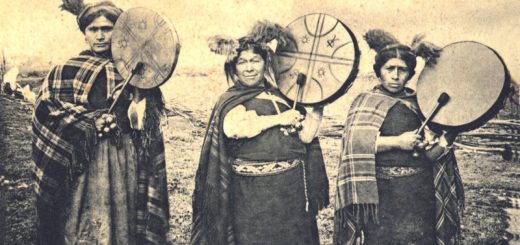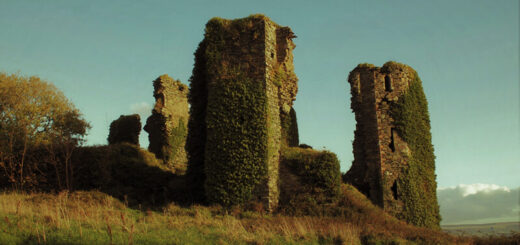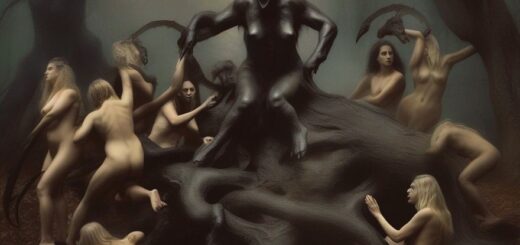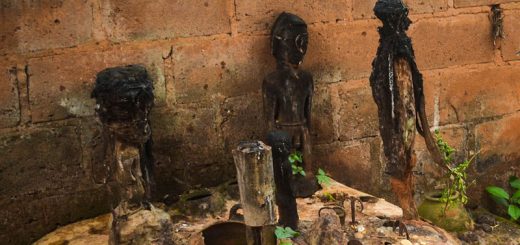La Cegua, Segua or Tzegua, a Central American horse headed Lamia
La Cegua (from Nahuatl, cihuatl, woman), also known as Segua or Tzegua, is a specter from Mesoamerican mythology. It is a character in Mexican and Central American legends appearing as a beautiful woman who transforms into a monster with a rotting horse’s head. She usually appears to womanizing men as beautiful and seductive and then turns into a horrible spectre. La Segua – in this aspect – has a relation with the Succubus and the Greek Lamia.
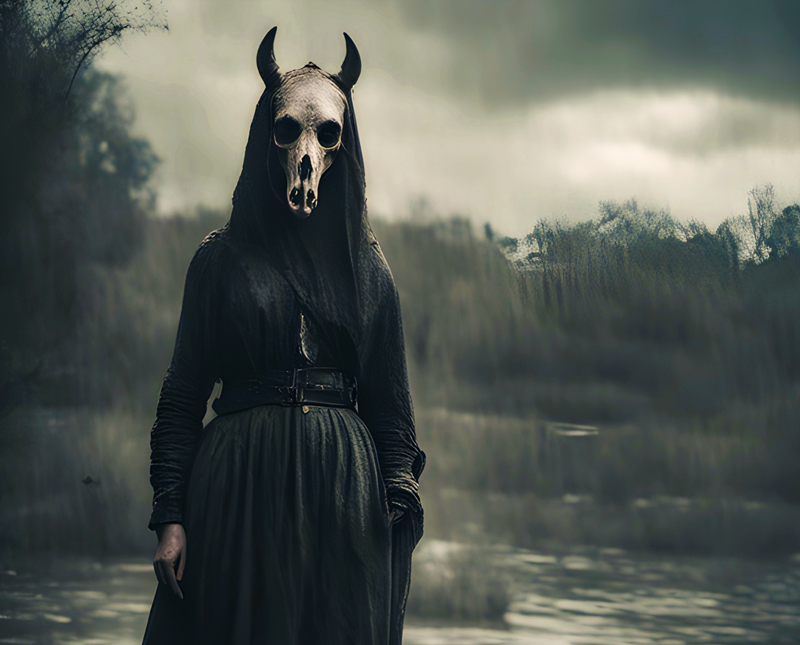
La Cegua appears as a very attractive woman who then turs into a hideous creature half woman half horse with a horse skull or rotting horse head and a putrifying breath.
La Cegua is a spectral being who materializes at night on lonely roads, asking for help to be taken to a nearby village. The specter usually appears to womanizing men in the form of a very beautiful woman, who then transforms into a monster with the head of a horse. The myth of the Cegua is of Mesoamerican origin and is related to the myth of the Siguanaba, with some variants, and in part, to that of the Llorona. The term “cegua” used to refer to this monster is more widespread in Costa Rica and Nicaragua, and has inspired literary works, theater, film, music, comics and other cultural manifestations.
Origin

Carlos Perezalonso’s book Cegua de lan Noche
Originally, the term cihuacóatl designated a Nahua goddess representing the fertile Mother Earth, who was known by many names. Possibly, her cult originated in the Huasteca (Gulf Coast of Mexico). In general, the Huastecans were a people rich in folklore and mythical imagination to create goddesses of fertility and lust, with a great prevalence of phallic cults and deities connected to sexual life.
In Mesoamerican mythology, the goddess Cihuacóatl always bore twins. Many of the wealth-giving vegetation deities passed from the Huastecans to other peoples. Cihuacóatl is also related to the genesis of another Mesoamerican legend: La Llorona. The word cegua also seems to be a contraction of ceguanaba. In fact, the term “cegua” comes from “cihuateteo”, a term that was used to refer to Nahua deities.
Furthermore, its origin also comes from the belief in nahualism. A nahual or nagual, in modern Mesoamerican belief, is a shaman, sorcerer or person who has the gift or ability to transform himself into an animal. From this, then, arises the belief that any woman can transform into a Cegua through witchcraft. On the other hand, it also has its origin in the goddess Xtabay of Mayan mythology. In Mayan mythology, Xtabay was the goddess of suicide, who rewarded suicides by taking them to a special paradise; she was also considered the goddess of carnal sins, since it was said that she seduced men by presenting herself as a beautiful woman who incited them to embrace her and when she had them, she revealed a monstrous aspect that killed them or drove them mad. In addition, Cegua also comes from the goddess Xilomen, the goddess of corn.
The term cegua to designate this spectral being is predominantly used in Nicaragua and Costa Rica, while in other Central American countries it is known by other names (X’tabay, Macihuatli in Mexico, Siguanaba in Guatemala and El Salvador, Sucia in Belize and Honduras), with slight variations in the legend.
It is worth noting that in Aguascalientes (Mexico), the local version of the Llorona describes the latter specter as a woman with the head of a horse skull, just like the Cegua, although she is not called that.
Legend

Cegua in a traditional Costa Rican masquerade
According to legend, the Cegua is a monstrous being that appears at night on lonely roads to womanizing men traveling alone, usually on horseback (or by car or motorcycle, in more modern accounts), in the form of a beautiful girl.
She is described as a very pretty young woman, white (or brunette, depending on the version), with an oval face, large black eyes, long curly black hair and a beautiful mouth, with lips as red as blood, with a divine voice that lulls like a siren’s song, and a body with pronounced curves, slender and tempting. She is dressed in full black or white and in some occasions, in a vaporous pink dress, and in other versions, in a luxurious period dress.
In the Nicaraguan version, she might also wear a delicate veil over her face. Upon seeing her, she would convince the man to put her on his horse. The man, on turning his head to gaze lasciviously at the young woman, finds that he has actually put on his horse a specter that, where it had a woman’s head, now presents a horse’s skull covered with rotting flesh (or a skull, according to other versions), glaring eyes, a cavernous snout full of enormous broken teeth and a stinking, putrid breath. The monster, then, clings tightly to the rider. The horse, which seems to realize what it is carrying, runs off at a wild gallop without anyone being able to restrain it. It is said that those who, in riding the maiden, have had evil intentions all die and are found lying with their eyes open and bulging; the others are rendered useless for life. There are also a couple of stories where the Cegua appears not as a woman, but as a child crying by the side of the road or near a river, and when the rider picks him up and puts him on the horse to calm him down, the horrible transformation takes place. Legend has it, in the Nicaraguan version, that you can tell it is near because it emits a deep hissing sound or diabolical laughter.
Costa Rica
The Costa Rican version of the legend narrates that the origin of the ghost would be in a beautiful woman of the city of Cartago, who, nevertheless, did not keep any consideration to her parents because she was very proud, to whom she frequently humiliated and disobeyed, because she was said to be very unhappy to be poor.
One day, this beautiful young woman received an invitation from a wealthy and handsome Spanish young man to attend a ball, to which her mother was opposed, because the young man was known for his conquering attributes and was not very formal with girls. When her mother refused, the young woman exploded in anger and blasphemed against her and filled her humble home with insults; her mother watched her and cried silently, before the attitude of her daughter, but it was not enough for the young woman to insult, but at one point she raised her hand to slap her, but she had not yet fully raised her hand, when out of nowhere came a black hand, with large nails (or a witch, according to other versions) and held the hand of the ungrateful daughter, throwing a curse at her:
“I curse you bad woman, for offending and pretending to hit the one who gave you life, from today and for the rest of the centuries men will approach you, but for your dreadful face they will run from you”.
Another version also tells that this woman, who was very vain, fell in love with the Spanish man, who abused her. Thus, she was condemned to wander for eternity looking for infamous men.
This is how since then the Cegua suddenly appears on the road, insinuating and provocative, asking a rider to take her on his horse, arguing that she is going to the nearest town and there is no man who can resist such a beautiful body and sweet entreaty, but once she is on the horse’s back her face transforms into that of a horrible beast similar to that of a neighing horse.
In the province of Guanacaste, also in Costa Rica, the Cegua, in addition to appearing to men on the roads, may also appear at dances and village festivals, where she flirts with any man who approaches her. The one who manages to conquer her, accompanies her to the open fields of the Guanacaste pampas, and under a leafy guanacaste tree, they give themselves to their love affairs, until late at night, when the man finally tries to kiss her, the metamorphosis occurs. The way to flee or escape from her is to put or show her mustard seeds, the Cegua likes mustard seeds very much; when the smell reaches her, the Cegua stops chasing her victim and pretends to eat the seeds, but as her hands became horse hooves, she vomits her soul when she cannot do it; thus the victim is saved.
Nicaragua

Artistic impression of La Segua
In Nicaragua, meanwhile, stories often mention not one, but several ceguas, who might even cooperate with each other to trap a victim. According to tradition, the terrible Cegua that frightens men would really be a betrayed witch, who is out for revenge against late-night womanizers. It is said that for this character to acquire her grotesque appearance, she must first enter a cornfield in the darkness of the night (usually at 11:00 PM), where she makes a pact with the lord of darkness. Then she would perform a ritual where she would vomit her soul in a large and long pot, to lose her soul and thus begin her transformation, with which she would acquire the powers of the Siguanaba. Thus, through the demonic powers united to that of the Siguanaba, she can turn her face into that of a skeletal mare; her hair becomes like the hair of corn and her teeth like the kernels of rotten corncob. In addition to that, the rest of her body is transformed: her legs become as long and sturdy as the hind legs of a horse, her feet become larger and so do her arms, giving her great physical strength and speed, which will ensure that she will not let her victim escape.
When the trasnochador is not cautious, the Cegua will first ambush him, playing with him, and then torment him but without killing him immediately. The specter seizes the man and bites him on the cheek, leaving him with the mark of a cheater and infidel. It is said that all those who see it end up crazy, because when they are let go, when they are found by someone, you can see in their face the terror of having seen it, their eyes wild, also with a high fever and other symptoms, such as diarrhea. This is expressed in the popular Nicaraguan saying “andar jugado de Cegua”. Subsequently, the almost insane victim, before dying, the only thing she says is: “I saw her, I saw her!
To elude this monster, the tradition indicates that the only way to protect oneself is to wear mustard seeds and a hat; then one would have to show her the hat with the glass upside down, an act that would impress her very much. After that, the mustard seeds should be taken out and thrown against her, since the mustard seed is said to be sacred (according to the Gospel of St. Matthew 13:31-32). With this action, the Blind woman would try to pick up the seeds, which would be impossible for her since she is transformed, because every time she finishes picking up the seeds they will fall from her hands again and she will try to pick them up again, if she does not do this ritual she would die of shame for having vomited her soul. Thus, in any case, she would never stop doing it and at dawn she would die irremediably, to be reborn again only until the following night. This tradition is said to have allowed walkers to escape very easily from her as she tried to gather mustard seeds. In other versions, being a specter that appears only to men traveling alone, the best way to elude her would be to go accompanied or, if one must walk alone, to carry some religious relic such as the scapular of Carmen or the Detente.
You may also like to read:
The incubus or succubus – nightmare or astral sex date?
The real vampire in Russia and Slavonic countries
Historical werewolf cases in Europe


